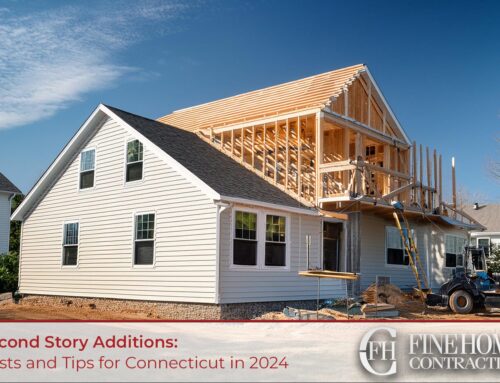For those of us with an interest in historic properties stepping into Connecticut’s stock of historic homes can be like wandering through a beautifully written story, where each chapter unfolds a distinct era of architectural brilliance. These homes are not just structures; they’re timeless canvases showcasing centuries of design and craftsmanship. The key to successfully reviving these cherished landmarks lies in choosing a contractor who not only understands their rich legacy but also brings the delicate touch and nuanced expertise needed for such noble endeavors. Today we’ll run through how to find the perfect artisan for your historic home, delving into the unique intricacies that each era of building requires, and give general tips on how best to invest in and protect your historic property in Connecticut.
CT’s Unique Historic Homes
Connecticut’s landscape is dotted with historic homes, each echoing a distinct architectural style, from the early Colonial to the grandiose Victorian era. These homes carry the charm of yesteryears but come with unique challenges. Their age means dealing with outdated plumbing, electrical systems, and often fragile structures. Understanding these challenges is the first step in a successful renovation.
Oftentimes the issues these older properties present are specific, and require a contractor with the exact experience and knowledge that the era of your home requires. Some common examples are properties with knob and tube wiring that needs to be updated, recreating historic architectural elements like woodwork and plaster, or navigating zoning and historic preservation guidelines.
Eras of Construction in Connecticut
Victorian Era Homes (Late 1800s): The Grandeur of the 1890s
Homes from the 1890s, often Victorian in style, are characterized by their ornate details, intricate woodwork, and unique architectural features like turrets and stained glass. These homes require careful restoration to preserve their elaborate craftsmanship. Beware of outdated elements like lead paint and knob and tube wiring, which are common in homes of this era and require professional attention for safe upgrading.
Early 20th Century Homes (1900-1940s): A Time of Transition
This era saw a transition from the ornate Victorian style to more streamlined designs. Homes from this period may feature a mix of styles, and renovations often involve updating key systems. Electrical wiring is a primary concern, as many homes initially used knob and tube wiring, which is now considered outdated and potentially hazardous.
Mid-Century Modern Homes (1940s-1960s): The Modernist Movement
The mid-century period introduced a minimalist, functional approach to design. Homes from this era often feature open floor plans, large windows, and a seamless integration with nature. The challenge with these homes is maintaining their unique architectural integrity while upgrading for energy efficiency and modern living standards.
Finding a Specialized Contractor
The first step is to find a contractor who specializes in the era of your historic home. This ensures they have the knowledge and experience to handle the specific challenges and preservation needs of your property.
Budgeting for a Historic Remodel
Budgeting for a historic renovation can be complex, particularly when dealing with homes of specific eras. Victorian-era homes, for example, might require more intricate restoration work, which can be costlier than simpler updates needed in mid-century modern homes. Starting with a detailed inspection, prioritizing essential repairs, and seeking out any grants or tax incentives for historic properties are great starting points to keeping your project at a reasonable budget.
It’s important to speak with your contractor about any necessary contingency finds, how they track expenses, and how detailed their estimate will be. A qualified contractor will provide a detailed, transparent estimate and be upfront about potential challenges that might impact the budget.
Conclusion: A Legacy of Preservation and Innovation
Finding the right contractor for your historic home renovation in Connecticut is a vital step in preserving a piece of history. By focusing on the specific needs of your home’s era and employing a contractor with the right expertise, you can ensure that your historic home is beautifully and safely restored for future generations.
Further Reading
Books
- “Restoring Your Historic House: The Comprehensive Guide for Homeowners” by Scott T. Hanson
- This book provides in-depth guidance on restoring historic homes, balancing preservation with modern comfort.
- “Renovating Old Houses: Bringing New Life to Vintage Homes” by George Nash
- Nash offers practical advice on the renovation of older homes, covering everything from structural repairs to aesthetic considerations.
- “The Old-House Doctor: The Essential Guide to Repairing, Restoring, and Rejuvenating Your Old Home” by Christopher Evers
- A handy guide for homeowners looking to repair and restore their historic properties, offering solutions to common problems.
Blogs
- Old House Online
- A blog dedicated to old house restoration and renovation, featuring articles, project ideas, and resources.
- URL (their website not working anymore): www.oldhouseonline.com
- The Craftsman Blog
- Run by Scott Sidler, this blog focuses on DIY tips, tutorials, and guidance for restoring old houses.
- URL: www.thecraftsmanblog.com










